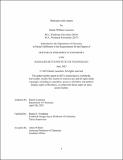Molecular color centers
Author(s)
Laorenza, Daniel William
DownloadThesis PDF (28.04Mb)
Advisor
Freedman, Danna E.
Terms of use
Metadata
Show full item recordAbstract
The inherent atomistic precision of synthetic chemistry enables bottom-up structural control over quantum bits, or qubits, for quantum information science. While molecular platforms may be used to create bespoke qubits for applications from nanoscale sensing to secure communication, such systems generally lack ground state spins capable of non-thermal initialization and single spin readout, hindering their integration with existing quantum technologies. To overcome this shortcoming, we developed general design principles to develop transition metal-based molecular spins wherein the ground state spin could be initialized and read out with optical light, deemed optical addressability, as a first step towards single spin addressability. With an inverse electronic structure design approach, we initially illustrated this optical addressable ground state in a series of tetravalent chromium, Cr(IV), ions coordinated to strong field aryl ligands. We then improved the coherent spin properties of these systems using symmetry control over the crystallographic host material, providing additional design criteria to develop qubits that may function in intrinsically noisy environments. Building upon these initial demonstrations, we illustrated that the electronic structure of may be readily tuned for targeted applications through modification of the ligands in a series of tetraalkyl Cr(IV) molecules. The amalgamation of this work, along with recent developments controlling the photophysical properties of metal-based spin centers, provide a platform to create the second generation molecular color centers that may be designed to address specific challenges or sensing tasks for quantum information science.
Date issued
2023-06Department
Massachusetts Institute of Technology. Department of ChemistryPublisher
Massachusetts Institute of Technology